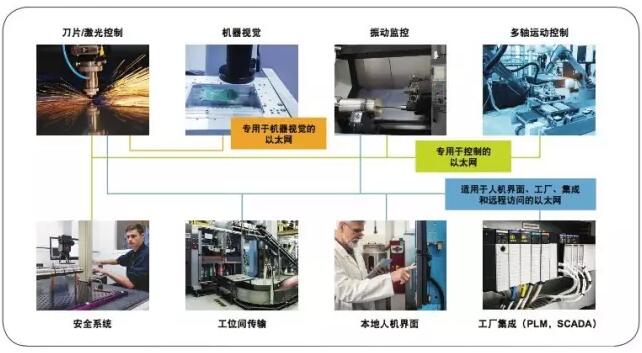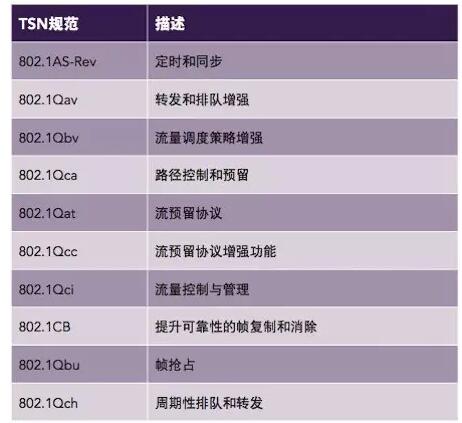Under the “Industry 4.0†transformation wave, visionary manufacturers are busy planning and building smart industrial enterprises in the future. They combine information technology (IT) domains with operational technology (OT) domains to build a new generation of intelligent systems that drive production, improve operations, enhance customer support, and analyze real-time data from the Industrial IoT. The simplest concept of the Internet of Things (IoT) is to connect to a wider world through embedded systems. On a broader level, it also involves data analysis (usually done in the cloud), human-computer interaction, and security. The challenge is that manufacturers need to fully integrate four essential industrial IoT technologies: network technology, processing technology, user interface technology and security technology. NXP's new QorIQ Layerscape LS1028A processor can easily meet these challenges.
1. Time-sensitive network
The convergence of the two can only be achieved by adjusting the network connecting the IT domain and the OT domain. The capabilities of the domain vary widely and the network is quite different. The IT domain contains a system that converts data into useful information. For manufacturers, it includes not only general-purpose systems such as finance, e-mail and customer relationship management systems, but also manufacturing-specific management planning and logistics systems. These systems are computer-based and have no hard real-time requirements, so IT networks can use "best effort" common Ethernet technology.
The OT domain includes systems that convert materials into products, as well as real-time embedded systems for implementing process control, workflow management, and process monitoring. The factory can use Industrial Ethernet technology to provide real-time response using standard Ethernet and perform operations using legacy industrial communication protocols. Unfortunately, many industrial Ethernet protocols are not interoperable with each other, nor can they be interoperable with standard Ethernet, thus limiting the large-scale development of technology vendors and slowing the pace of innovation. A single machine in a factory may be connected to a different Industrial Ethernet network, each running a specific protocol with different control functions, as shown in Figure 1. Manufacturers must deploy gateways to transfer data between different networks or transfer data to IT systems.

Figure 1: Modern device block diagram (Source: AVNU)
Industry 4.0 is not well supported because traditional industrial Ethernet protocols have the limitations of the above interconnections. In addition, IT-oriented standard Ethernet does not provide the real-time performance required to control the system. However, the IEEE established a team in 2004 to develop audio/video streaming standards for consumer applications, and then expanded to standardization for professional applications. The team developed an audio/video bridging (AVB) standard covering network equipment time synchronization (with IEEE 1588), traffic shaping, and admission control. While not fully meeting the needs of industrial applications, these standards provide a framework for more accurate Ethernet traffic management.
After recognizing the potential for using AVB for industrial use, the IEEE team renamed it a time-sensitive network (TSN) and began to revise the 802 standard series to meet industrial and automotive applications while improving professionalism. The performance of audio and video applications. The new standard defines time-sensitive traffic shaping and critical traffic scheduling strategies. In order to facilitate scheduling, the new standard adds a non-critical frame preemptable scheduling strategy, and the new standard for redundant network paths improves network reliability. Now, industrial enterprises can deploy only one IEEE standard Ethernet network, which can transmit the control traffic with high real-time requirements in the OT system, and can transmit the normal Ethernet traffic in the IT system. Given the critical network technologies of the Industrial Internet of Things have been identified, industrial companies can focus on the strategic benefits of OT-IT convergence and Industry 4.0. Figure 2 shows some of the new specifications that are part of the TSN specification and have industrial applications.

Figure 2: TSN specification
2, processing
Just as the network must support time-critical features, the process must be the same. The use of a real-time operating system (RTOS) helps ensure that when a control packet arrives at a port that supports TSN, the CPU can receive and process the packet. The ability to respond to control packets also helps the CPU process processor events from other inputs and execute loops that control the system to which the processor belongs. These loops may need to run in less than 30 microseconds - an accuracy that traditional IT-derived operating systems cannot.
To increase the degree of automation, it is necessary to increase the processing power of the embedded controller. Higher performance processing operations can be used to reduce control loop timing, allowing faster movement of the arm and assembly line and increased plant throughput. It also increases the number of axes managed by a single motion controller, giving the robot more joints to work in tighter spaces or performing tasks that were not possible with previous generation plant robots. Robots that can learn to mimic human operations also require image processing functions as well as new machine learning algorithms.
Commercial RTOS includes VxWorks from Wind River and Nucleus from Mentor Graphics. These suppliers have long supported the NXP QorIQ series and its predecessors. With the advent of industrial-grade Linux, open source solutions have become another option. Industrial companies and OEMs have the flexibility to add new features to their systems.
Unlike non-real-time embedded Linux distributions that focus on IT, industrial-grade Linux provides the determinism, manageability, industrial networking, and security that OT requires. One way to add real-time functionality to Linux is to apply the PREEMPT_RT patch to the kernel to eliminate situations where one software process is blocked from another. In this scenario, the application is coded as a regular Linux API. Another approach taken by Xenomai is to add the classic RTOS API to a Linux system, which makes it easy to port legacy RTOS applications to Linux. Xenomai also provides a mechanism for device drivers to respond to peripherals in real time, further securing the real-time capabilities of Linux. To reduce the difficulty of switching from traditional RTOS to Linux, NXP is working with the industrial Linux community on Linux distributions to integrate standard real-time enhancements and TSN stacks while preserving standard Linux functionality.
Processing functions must also be available for analysis. The Internet of Things involves not only network embedded systems, but also data capture from sensors, analysis of these data, and guidance of system response. We usually think of remote servers performing analysis in the cloud. However, the amount of data that needs to be transmitted and analyzed, the ability to make timely decisions, and the confidentiality of the data all drive manufacturers to process manufacturing data locally. As long as the processor is powerful enough, the analysis process can be performed not only on the plant's computer, but also on the production equipment. In addition, remote operation management can be implemented using the processing functions in the Industry 4.0 specification, enabling autonomous coordination between machines and greater efficiency by connecting production data and IT systems such as enterprise resource planning systems.
Apple Headset Wireless Charger
Qi Certified Charger,Apple Wireless Charger,Apple Watch And Phone Charger,Apple Headset Wireless Charger
wzc , https://www.dg-wzc.com
![<?echo $_SERVER['SERVER_NAME'];?>](/template/twentyseventeen/skin/images/header.jpg)